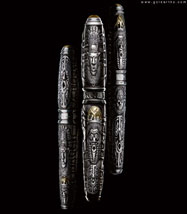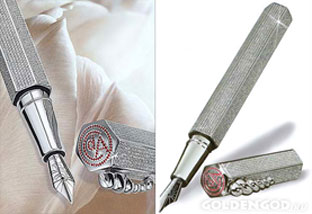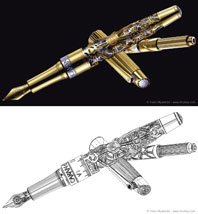Write: Don’t write it off
Swiss brand Caran d’Ache hopes to bring the art of writing with a pen into mainstream again, writes Syida Lizta Amirul Ihsan.
A person used to be known by his or her handwriting, when cursive lines were eloquently drawn on paper, almost calligraphic in presentation, making reading a visual pleasure. When I was a child, I was told that one had to refine his or her handwriting as he or she grew older, just as with manners, good taste and virtues.
And isn’t it curious how doctors seem to have some of the most illegible handwriting? There have been times I thought I would be wrongly medicated because the nurses wouldn’t be able to decipher properly what the doctors had prescribed!
Writing is now deemed a tedious process since one can type, erase, delete, rephrase sentences at the touch of a button on phones and computers. With the use of emails, text messages and phone calls, writing has been written off as archaic and deemed not immediate enough as a communication medium.
But writing remains an art. Artists still need pencils to sketch, fashion designers still draw with their pencils, and there’s nothing more pleasurable than reading a handwritten letter from your beloved.Well, Swiss writing instrument brand Caran d’Ache is on a mission to get people to write again. Led in the Asia-Pacific by its jovial and charismatic president Angelo Ponzetta, the brand believes that writing will never die.
“Idea comes to the brain, to the arm and to the pen. You can communicate with an email, but there’s something special that goes into handwritten cards”.
I recall while I was on a flight from Dubai to Zurich to meet Ponzetta in Basel, I had penned questions on paper, not on the Notes program on my iPhone.
And what he said is true — ideas flow freely through writing, not typing.
Based in Tokyo for the last 19 years, Ponzetta is a strong advocate of the art of handwriting. He sends handwritten Christmas and thank-you cards and even signs each of his name card— with different coloured pens.
“I have nine shades. What colour did you get?”
“Turquoise,” I answered, as he showed me other colourfully signed cards.
“Whenever I send greeting cards, I always get a reply and most of the time people tell me how nice it is to receive handwritten ones,” he says.The 51-year-old German-Italian uses fountain pens most of the time. He, like my father, belongs to a dying breed of gentlemen who pride themselves in their handwriting and the medium in which it is conveyed.
In Switzerland, where Ponzetta grew up, every elementary school student had to write using a fountain pen, never a pencil. “If you start writing with a fountain pen, you will soon discover the pleasure of writing. It’s almost like calligraphy”.
Ponzetta’s job fits his passion for writing to a tee. Caran d’Ache began as a pencil manufacturer which started making hexagonal pencils in 1915 when most lead pencils were round. So iconic is the shape that the brand is now known for its six-sided pens.
Vintage pens are also making a comeback, Ponzetta tells me, so the company is reproducing vintage models from the 1960s and 1970s.
“We make very few of these pens, but they are extremely popular because people want something classic, not just for their use but also as heirlooms”.
To mark the 50th anniversary of the first manned space flight, the brand also created the prestigious Yuri Gagarin Limited Edition.
The brand has always been inspired by Russian history. In fact, “karandash” is Russian for pencil. Caran d'Ache was the pseudonym of the 19th century Russian-blood French satirist and political cartoonist Emmanuel Poiré.
Ponzetta believes that Caran d’Ache’s strong link to history is largely due to the fact that writing in itself is part of human civilization.
“Cavemen wrote stories on walls. The Egyptians had their hieroglyphs before they wrote on parchment and paper. And thousands of years later, when almost everything would be found in print, writing would remain a niche and an art much sought-after”.
Ponzetta has achieved much through the years, having started Caran d’Ache’s operations in Asia, which now accounts for 25 per cent of the company’s global profits with Japan being its Asian stronghold.
But his most important achievement is a personal one, he says. His 16-year-old daughter writes with fountain pens, experimenting with different nibs. Young people, he tells me, want to be different and handwriting sets his daughter apart from her peers.
“See, it’s already happening. People are writing again, and it’s the young, not the old, who are trailblazing the trend,” he says.
It would be premature to conclude that handwriting will become mainstream again, but the fact that beautiful handwriting is always a delight to read and a skill to be proud of is beyond doubt.
Source: newstraitstimes


